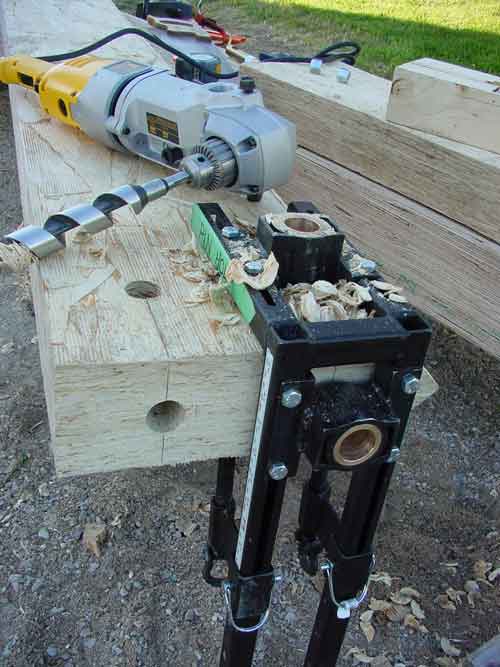Fifteen years ago my family and I had unexpected house guests from Switzerland for a few days, and the experience helped me realize how little homage Canadian home design usually pays to a resource that’s abundant here, yet rare in most other parts of the world. I’d included exposed timbers and beams in my house when I built it, and though the wood was easy to source, and it didn’t cost me more than an equivalent amount of regular, construction-grade
lumber, the sight of exposed wood astonished our Swiss guests. “There are many nice new homes where I live, but you’d never see such magnificent wood being used in our country,” explained Peter. “We just don’t have the trees.”
Why Play Peek-a-Boo with Your Timber?
So how come we turn so many of our magnificent saw logs into 1 1/2”-thick joists and studs, then bury it behind drywall? How come homes aren’t built with at least a few 6×8, 8×10 and 10×12 timbers where it would be visually appropriate? The biggest deterrent is skills and attitude. Working timbers into a modern home takes more time and ability than machine-gunning 2x6s together with a nail gun. Another issue is vision. Few people understand the kind of options we have in this country for featuring great, big wood in our houses, but a little-known Canadian product called Timberlinx (877.900.3111) is bridging the skills and efficiency gap between hidden lumber and magnificent, visible timbers.
The Visible Beauty of Timberlinx
Timberlinx is a system of simple, hidden hardware that eliminates the need for time-consuming, skill-dependent traditional joinery methods for connecting timbers into parts of a building frame. I first learned about Timberlinx in the autumn of  2003, and I’ve used the system on three projects since then with great success. Instead of using saws and chisels to create the kind of interlocking mortises, tenons and dovetail joints traditionally used to connect timbers, Timberlinx uses a metal tube set in a hole that spans the gap between adjoining timbers. Expanding metal pins fit into oval holes at the ends of each tube, and when you make these pins bigger by turning a large bolt in the centre, it draws the joint tight. Cover these access holes with a short length of wooden dowel and the result looks just like a traditional pegged timber frame joint. I’ve used the Timberlinx system to connect solid wood timbers as well as engineered glue-laminated beams and it works equally well with both.
2003, and I’ve used the system on three projects since then with great success. Instead of using saws and chisels to create the kind of interlocking mortises, tenons and dovetail joints traditionally used to connect timbers, Timberlinx uses a metal tube set in a hole that spans the gap between adjoining timbers. Expanding metal pins fit into oval holes at the ends of each tube, and when you make these pins bigger by turning a large bolt in the centre, it draws the joint tight. Cover these access holes with a short length of wooden dowel and the result looks just like a traditional pegged timber frame joint. I’ve used the Timberlinx system to connect solid wood timbers as well as engineered glue-laminated beams and it works equally well with both.
The system is based on a robust metal drilling jig that guides a 1 1/8” diameter self-feeding drill bit. This bores the necessary intersecting holes for the system – one long hole for the central tube, and two shorter ones for the expanding pins. There are a handful of different variations on Timberlinx hardware, depending on the specific joinery situation you’re facing.
 Be Open Minded When It Comes to Alternative Framing Options
Be Open Minded When It Comes to Alternative Framing Options
Although you may not understand exactly how Timberlinx works from my short description here, that’s okay. What really matters is that you realize there’s an efficient alternative to traditional timber framing methods, and it’s probably not something your contractor knows about. Like I said, Timberlinx isn’t something you’ll see in every hardware store.
Although I’m a purist when it comes to wood, and I do prefer and use traditional joinery methods in some of my own work, I consider a little bit of cheating with hidden metal hardware a small price to pay if it means replacing hidden 2x6s and 2x10s with the magnificence of grand, exposed timbers that few other people around the world can enjoy.
As Canadians, we enjoy access to wood that the rest of the world can only wish for. And while there’s certainly a big place for conventional lumber framing methods, doesn’t it make sense to let a little bit of our extraordinary Canadian timber show through now and then?

 Be Open Minded When It Comes to Alternative Framing Options
Be Open Minded When It Comes to Alternative Framing Options


